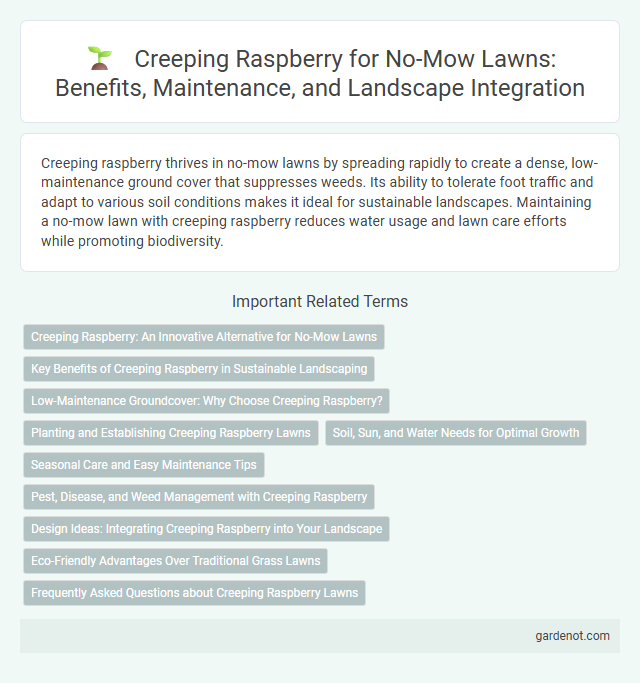Creeping raspberry thrives in no-mow lawns by spreading rapidly to create a dense, low-maintenance ground cover that suppresses weeds. Its ability to tolerate foot traffic and adapt to various soil conditions makes it ideal for sustainable landscapes. Maintaining a no-mow lawn with creeping raspberry reduces water usage and lawn care efforts while promoting biodiversity.
Creeping Raspberry: An Innovative Alternative for No-Mow Lawns
Creeping raspberry (Rubus calycinoides) offers a resilient and low-maintenance ground cover ideal for no-mow lawns, thriving in various soil types and partial shade conditions. This perennial plant provides dense foliage that suppresses weeds and reduces soil erosion, making it an eco-friendly alternative to traditional grass. Its ability to spread rapidly without requiring regular mowing or frequent watering supports sustainable landscaping practices.
Key Benefits of Creeping Raspberry in Sustainable Landscaping
Creeping raspberry (Rubus hayata-koidzumii) offers exceptional ground cover that reduces soil erosion and suppresses weed growth, minimizing the need for chemical herbicides in sustainable landscaping. Its drought tolerance and low maintenance requirements decrease water usage and labor, supporting eco-friendly garden practices. The plant's dense growth habitat provides habitat for beneficial insects, enhancing local biodiversity within no-mow lawn designs.
Low-Maintenance Groundcover: Why Choose Creeping Raspberry?
Creeping raspberry is an ideal low-maintenance groundcover due to its drought tolerance and ability to thrive in various soil types, reducing the need for frequent watering and fertilization. Its dense growth habit effectively suppresses weeds, minimizing garden upkeep and enhancing lawn aesthetics. This resilient plant also supports erosion control on slopes and pathways, making it a sustainable choice for no-mow lawns.
Planting and Establishing Creeping Raspberry Lawns
Creeping raspberry (Rubus calycinoides) thrives in well-drained, fertile soil with partial shade, making it an excellent choice for no-mow lawns. Planting involves spacing runners or rooted cuttings about 12 inches apart to ensure rapid ground coverage and weed suppression. Regular watering during the establishment phase promotes dense growth, reducing bare spots and minimizing maintenance needs in established creeping raspberry lawns.
Soil, Sun, and Water Needs for Optimal Growth
Creeping raspberry thrives in well-drained, moderately fertile soil with a slightly acidic to neutral pH range of 5.5 to 7.0, ensuring healthy root development and growth. It prefers full sun to partial shade, requiring at least 4 to 6 hours of sunlight daily to maintain vibrant foliage and robust spreading. Consistent moisture is crucial, with moderate watering to keep the soil evenly moist without waterlogging, promoting optimal growth for this no-mow lawn ground cover.
Seasonal Care and Easy Maintenance Tips
Creeping raspberry thrives in well-drained soil and requires minimal mowing, making it an ideal choice for no-mow lawns. Seasonal care involves light pruning in early spring to control growth and remove dead stems, enhancing its dense mat formation. Regular watering during dry spells and occasional fertilization promote healthier foliage and weed suppression with low maintenance effort.
Pest, Disease, and Weed Management with Creeping Raspberry
Creeping raspberry (Rubus calycinoides) demonstrates strong resistance to common lawn pests such as aphids and spider mites, reducing the need for chemical interventions in no-mow lawn settings. Its dense, low-growing foliage inhibits weed establishment by minimizing sunlight penetration to the soil, effectively suppressing invasive species. Disease incidence is minimal, with occasional powdery mildew controlled through proper air circulation and avoiding excessive moisture.
Design Ideas: Integrating Creeping Raspberry into Your Landscape
Creeping raspberry offers a low-maintenance ground cover ideal for no-mow lawns, enhancing landscape aesthetics with its dense, bright green foliage and small white flowers. Integrate creeping raspberry along garden edges, under trees, or between stepping stones to create natural pathways and reduce bare soil exposure. Its ability to thrive in shade and withstand foot traffic makes it a versatile choice for sustainable and visually appealing landscape designs.
Eco-Friendly Advantages Over Traditional Grass Lawns
Creeping raspberry offers an eco-friendly alternative to traditional grass lawns by enhancing soil health through natural ground coverage that reduces erosion and water runoff. This low-maintenance ground cover requires significantly less water and no chemical fertilizers or pesticides, promoting biodiversity and minimizing environmental impact. Its dense growth suppresses weeds effectively, further diminishing the need for harmful herbicides commonly used in conventional lawn care.
Frequently Asked Questions about Creeping Raspberry Lawns
Creeping raspberry (Rubus pentalobus) is a low-maintenance ground cover ideal for no-mow lawns due to its dense growth and ability to suppress weeds. It thrives in partial shade to full sun, requires minimal watering once established, and is resistant to pests and diseases. Frequently asked questions include concerns about its spread, with most gardeners noting it spreads moderately via runners but remains manageable with occasional trimming.
Creeping raspberry Infographic

 gardenot.com
gardenot.com